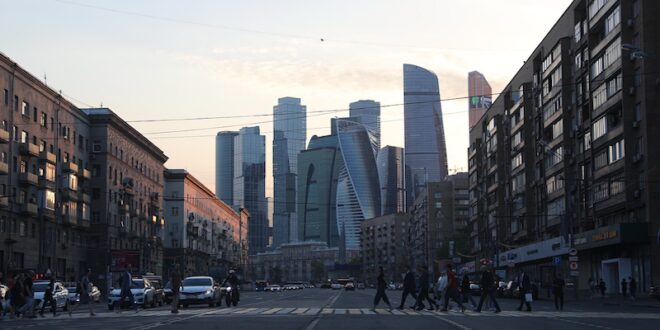With its tastefully restored Tsarist and Soviet neo-classical architecture, newer swanky office towers, well-landscaped parks and clean and efficient public transport, Moscow is one of the most liveable cities in Europe. Behind the rise of the capital and other large cities in Russia from the ashes of the Soviet Union and the wild 1990s, is a group of people who do not get enough credit for the restoration and development of these metropolises – Central Asian migrants.
An estimated 9 million[1] Central Asians reside and work in Russia, and almost every major city in the country is dependent on their labour. Migrants from Uzbekistan, Tajikistan, Kyrgyzstan (Kyrgyz Republic), and to a lesser extent Kazakhstan and Turkmenistan work in construction, sanitation, municipal services, transport, personal care and as taxi drivers and couriers. The role of these workers is not very different from the North African immigrants in post-World War II France, Belgium, and the Netherlands or Turkish “guest workers” in Germany.
The phenomenon of migration to Russia from the former Soviet republics is seen as beneficial all around. Russia gets modernised infrastructure, while remittances bring in much-needed capital to Central Asia. According to a June 2022 report by the United Nations’ International Organisation for Migration (IOM)[2], remittances from Russia to Kyrgyzstan and Tajikistan accounted for 31% and 27% of GDP respectively in 2020. A majority of these funds are estimated to come from their workers in Russia. In 2021, remittances from Russia were 55% of those transferred to Uzbekistan and 51% in the case of Kazakhstan.
Its an easy commute. Under an agreement[3] signed during the formation of the Commonwealth of Independent States (CIS) in 1992, citizens are allowed to travel within the nine-country commonwealth without a visa. This visa-free access last 90 days, but those intending to work in Russia need to apply for work permits once they are in the country. The Russian Federal Migration Service usually fast tracks such permits for those working for government such as municipalities and public hospitals, but those working for private contractors often face delays and exploitation.
According to the Federation of Migrants in Russia[4], a public organisation that helps migrants adapt and integrate into Russian society, the largest source of migrants to Russia from Central Asia is Uzbekistan, with almost 5 million Uzbeks legally registered in the country in 2022. Russia is also home to over 2 million Tajiks.
The 1 million citizens of the Kyrgyz Republic living in Russia have an added advantage: easy access to the Russian labour market thanks to their country being a member of the Eurasian Economic Union[5]. They can legally pursue employment in Russia by registering with the authorities, and then are on a par with Russian citizens.
It’s a limited equality. During the Soviet days, Moscow and other major cities in Russia had an overwhelming ethnic Russian majority with most migrants being virtually invisible as they came from the Baltic states or Eastern European Communist Bloc countries. Now with the majority of migrants coming from Central Asia, they are clearly visible and have at times been used as a scapegoat for crime and social problems by the police and opportunistic politicians
Right until the late 2000s, marches in city centres during some national holidays called on Russia to evict migrants from Central Asia and the Caucasus. But the Kremlin did not approve of this targeting, and the marches have lost steam. Still, there are conversations in Moscow with some ethnic Russians who complain about too many people from former Soviet republics residing in the city. The crude slur sometimes used to describe such migrants is “churka,” a versatile word that originally meant a block of wood but is now used for labourers who have a limited understanding of the Russian language and customs.
Facing a class barrier, most migrants only interact with ethnic Russians in a professional capacity. This writer’s conversations with migrants from Central Asia have usually been in taxis by aggregators such as Uber or Yandex. Many complain of being treated with suspicion by local citizens and the authorities alike. While physical racist assaults on such migrants are rare, it is not uncommon to see service providers being rude to migrants or police stopping them in metro stations, railway terminals and even airports for identity checks. It is the plight of migrants everywhere, and Russia is no exception.
Many Central Asian migrants in Russia face regular threats of deportation for supporting causes back home. In April 2021 for instance, Amnesty International[6]called on Russia to stop the deportation of Tajik migrants who were expelled for taking part in a peaceful protest against the forced return of a Tajik human rights activist. The deportation scenario was repeated later in the year when Tajiks from the Pamir Region protested Tajikistan President Emomali Rahmon.
Nevertheless, the relationships are established and the system works. Russia has a labour shortage and a shrinking population – 130 million in 2050, from the present 145 million. It is fast tracking citizenship for Central Asians. According to the Russian Interior Ministry, more than 103,000 citizens of Tajikistan, over 50,000 from Kazakhstan and over 19,000 from the Kyrgyz Republic were given Russian citizenship in 2021.
These days, the sanctions imposed on Russia by western countries in the wake of Moscow’s “special operation” in Ukraine, are hitting the Central Asian countries that depend on remittances, hard. The exit of western companies from Russia is expected to cause a 6% fall in Russian GDP in 2022, according to the IMF[7]and analysts predict an 8%-9% fall in retail trade this year. The loss of jobs will first hit migrant workers.
Russian media reports suggest that close to 200,000 migrants have already returned to Central Asia since March 2022, and the IOM predicts a decline of 21% in remittances to Uzbekistan in 2022 and 17% to Kazakhstan. But Vadim Kozhenov, President of the Federation of Migrants in Russia does not believe that this is a special phenomenon. “There is no outflow at all. Even if a thousand people decided to leave, this is minimal when it comes to the millions (of migrants) that exist,” he said at a press conference. “Plus, we must understand that the situation is difficult now, there are always people who are prone to the mood that ‘everything is bad here, you need to go somewhere.’”
Renate Held, Director of IOM’s Vienna Regional Office said in the report that “While the majority of migrant workers have indicated a preference to remain in the Russian Federation for the time being, we are likely to see steadily increasing returns should the economy take a turn for the worse.”
For now, though, the marriage of convenience between Central Asian migrants and Russia, continues. For Central Asian labourers, who have a varying degree of proficiency in Russian and little to no understanding of Chinese, English or other foreign languages, Russia remains the safest bet for immigration. Russia is still building infrastructure: [8] $104 billion on expansion of highways and railways to health care and social infrastructure from 2022 to 2024. There is plenty of work to be had.
 Eurasia Press & News
Eurasia Press & News


